AMD Radeon HD 7970 Review: 28nm And Graphics Core Next, Together As One
by Ryan Smith on December 22, 2011 12:00 AM EST- Posted in
- GPUs
- AMD
- Radeon
- ATI
- Radeon HD 7000
Building Tahiti & The Southern Islands
Now that we’ve had a chance to go over the basis of the Graphics Core Next architecture, let’s talk about the finished products.
Today AMD will be launching Tahiti, the first GPU of the Southern Islands family. Southern Islands will initially be composed of 3 GPUs: Tahiti, Pitcairn, and Cape Verde. Tahiti is the largest and most powerful member of the Southern Islands family, while Pitcairn and Cape Verde get progressively smaller. AMD has not yet announced the branding or launch dates for Pitcarn and Cape Verde, but it typically takes AMD around 6 months to launch a complete family. As such it’s reasonable to expect that all 3 GPUs will have launched by the end of June although there’s a good likelihood of it happening sooner than that.
All 3 GPUs are based on the GCN architecture, and as family members will have similar features while varying the number of functional units accordingly. Along with the architecture change Southern Islands brings with it a slew of additional features that we’ll get to in the following pages, including Partially Resident Texture (PRT) support, PCIe 3.0, FastHDMI, Direct3D 11.1, and AMD’s fixed-function H.264 encoder, the Video Codec Engine.
But today is all about Tahiti, so let’s get down to business.
As we quickly covered in our introduction, Tahiti is a 4.31B transistor GPU based on the GCN architecture and built on TSMC’s new 28nm High-K process. Due to TSMC canceling their 32nm process last year AMD has had to wait over 2 years for the next full node rather than taking advantage of the half-node process as they typically do, and as a result the jump from Cayman at 40nm to Tahiti at 28nm is much bigger than with past product launches. Whereas Cayman had 2.64B transistors and a die size of 389mm2, Tahiti has a whopping 63% more transistors than Cayman and yet it’s still smaller, coming in at a slightly more petite 365mm2.
At this point AMD hasn’t provided us with the typical board power values for 7970, but we do know that PowerTune is limited to 250W. In terms of design 7970 is clearly intended to work in similar environments as the 6970, in which case power consumption should be similar to the 6970.
Interestingly enough however we’re hearing that 7970 cards are proving to be very overclockable, which is a good sign for the state of TSMC’s 28nm process, and at the same time a bit distressing. Moore’s Law has continued to hold with respect to transistor density, but the power consumption benefits of using smaller nodes has continued to wane. Having a lot of overclocking headroom means that the 7970 has the potential to be much faster, but it also means that the 7970 (and 28nm GPUs in general) are going to be bottlenecked by power. In which case seeing as how we’re already approaching 300W with single-GPU video cards, the performance gains realized from future fabrication processes would be limited to the ever diminishing returns on power consumption improvements.
Diving deeper into Tahiti, as per the GCN architecture Tahiti’s 2048 SPs are organized into 32 Compute Units. Each of these CUs contains 4 texture units and 4 SIMD units, along with a scalar unit and the appropriate cache and registers. At the 7970’s core clock of 925MHz this puts Tahiti’s theoretical FP32 compute performance at 3.79TFLOPs, while its FP64 performance is ¼ that at 947GFLOPs. As GCN’s FP64 performance can be configured for 1/16, ¼, or ½ its FP32 performance it’s not clear at this time whether the 7970’s ¼ rate was a hardware design decision for Tahiti or a software cap that’s specific to the 7970. However as it’s obvious that Tahiti is destined to end up in a FireStream card we will no doubt find out soon enough.
Meanwhile the frontend/command processor for Tahiti is composed of 2 Asynchronous Command Engines (ACEs) and 2 geometry engines. Just as with Cayman each geometry engine can dispatch 1 triangle per clock, giving Tahiti the same theoretical 2 triangle/clock rate as Cayman. As we’ll see however, in practice Tahiti will be much faster than Cayman here due to efficiency improvements.
Looking beyond the frontend and shader cores, we’ve seen a very interesting reorganization of the rest of the GPU as opposed to Cayman. Keeping in mind that AMD’s diagrams are logical diagrams rather than physical diagrams, the fact that the ROPs on Tahiti are not located near the L2 cache and memory controllers in the diagram is not an error. The ROPs have in fact been partially decoupled from the L2 cache and memory controllers, which is also why there are 8 ROP partitions but only 6 memory controllers. Traditionally the ROPs, L2 cache, and memory controllers have all been tightly integrated as ROP operations are extremely bandwidth intensive, making this a very unusual design for AMD to use.
As it turns out, there’s a very good reason that AMD went this route. ROP operations are extremely bandwidth intensive, so much so that even when pairing up ROPs with memory controllers, the ROPs are often still starved of memory bandwidth. With Cayman AMD was not able to reach their peak theoretical ROP throughput even in synthetic tests, never mind in real-world usage. With Tahiti AMD would need to improve their ROP throughput one way or another to keep pace with future games, but because of the low efficiency of their existing ROPs they didn’t need to add any more ROP hardware, they merely needed to improve the efficiency of what they already had.
The solution to that was rather counter-intuitive: decouple the ROPs from the memory controllers. By servicing the ROPs through a crossbar AMD can hold the number of ROPs constant at 32 while increasing the width of the memory bus by 50%. The end result is that the same number of ROPs perform better by having access to the additional bandwidth they need.
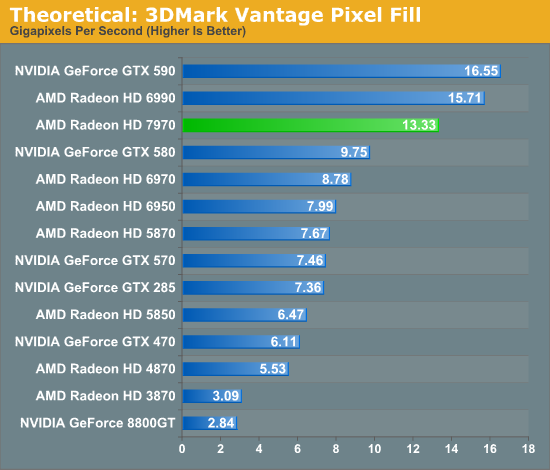
The big question right now, and one we don’t have an answer to, is what were the tradeoffs for decoupling the ROPs? Clearly the crossbar design has improved ROP performance through the amount of memory bandwidth they can access, but did it impact anything else? The most obvious tradeoff here would be for potentially higher latency, but there may be other aspects that we haven’t realized yet.
On that note, let’s discuss the memory controllers quickly. Tahiti’s memory controllers aren’t significantly different from Cayman’s but there are more of them, 50% more in fact, forming a 384bit memory bus. AMD has long shied away from non-power of 2 memory busses, and indeed the last time they even had a memory bus bigger than 256bits was with the ill-fated 2900XT, but at this point in time AMD has already nearly reached the practical limits of GDDR5. AMD’s ROPs needed more memory bandwidth, but even more than that AMD needed more memory bandwidth to ensure Tahiti had competitive compute performance, and as such they had little choice but to widen their memory bus to 384bits wide by adding another 2 memory controllers.
It’s worth noting though that the addition of 2 more memory controllers also improves AMD’s cache situation. With 128KB of L2 cache being tied to each memory controller, the additional controllers gave AMD 768KB of L2 cache, rather than the 512KB that a 256bit memory bus would be paired with.
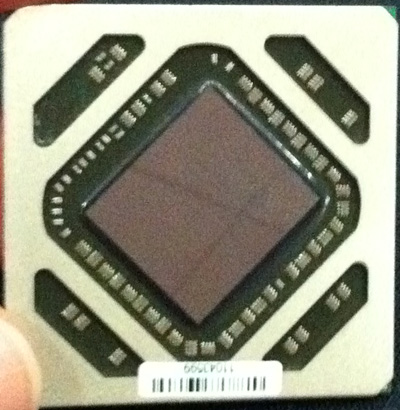


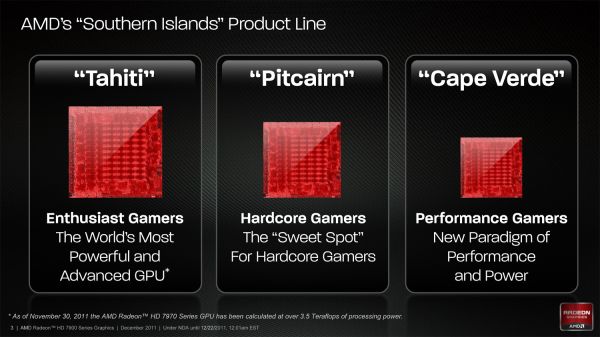
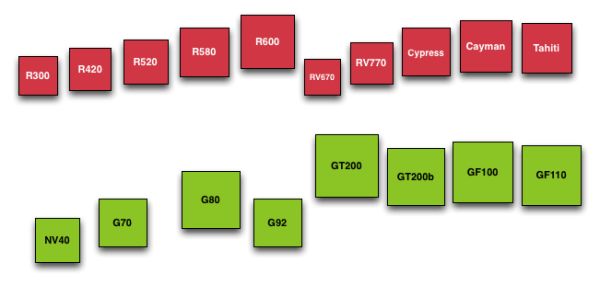
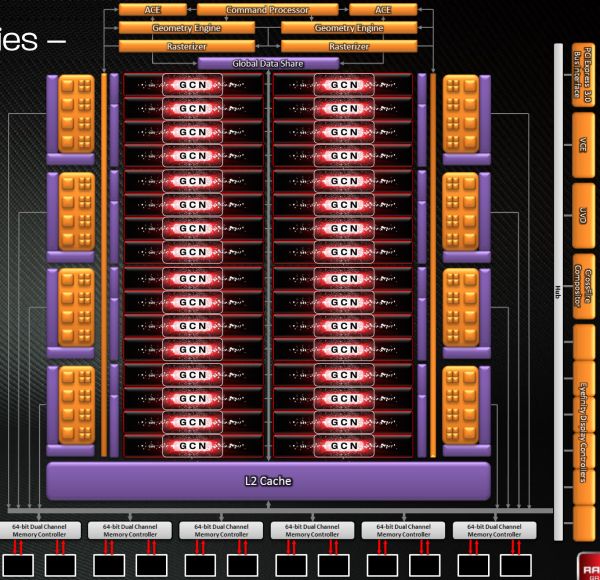








292 Comments
View All Comments
gevorg - Thursday, December 22, 2011 - link
37.9dB is a horrible testbed for noise testing! WTF!mavere - Thursday, December 22, 2011 - link
Seriously!With the prevalence of practically silent PSUs, efficient tower heatsinks, and large quiet fans, I cannot fathom why the noise floor is 37.9 dB.
Finally - Thursday, December 22, 2011 - link
As usual, AT is shooting straight for the brain-dam, I mean, ENTHUSIAST crowd feat. a non-mentioned power supply that should be well around 1000W in order to drive over-priced CPUs as well as quadruple GPU setups.If you find that horrendous they will offer you not to read this review, but their upcoming HTPC review where they will employ the same 1000W power supply...
B3an - Thursday, December 22, 2011 - link
*face palm*1: 1000+ Watt PSU's are normally more quiet if anything as they're better equipped to deal with higher power loads. When a system like this uses nowhere near the PSU's full power the fan often spins at a very low RPM. Some 1000+ PSU's will just shut the fan off completely when a system uses less than 30% of it's power.
2: It's totally normal for a system to be around 40 dB without including the graphics cards. Two or 3 fans alone normally cause this much noise even if they're large low RPM fans. Then you have noise levels from surroundings which even in a "quiet" room are normally more than 15 dB.
3: Grow some fucking brain cells kids.
andymcca - Thursday, December 22, 2011 - link
1) If you were a quiet computing enthusiast, you would know that the statement"1000+ Watt PSU's are normally more quiet if anything"
is patently false. 1000W PSUs are necessarily less efficient at realistic loads (<600W at full load in single GPU systems). This is a trade-off of optimizing for efficiency at high wattages. There is no free lunch in power electronics. Lower efficiency yields more heat yields more noise, all else being equal. And I assure you that a high end silent/quiet PSU is designed for low air flow and uses components at least as high in quality as their higher wattage (non-silent/non-quiet) competitors. Since the PSU is not decribed (a problem which has been brought up many times in the past concerning AT reviews), who knows?
2) 40dB is fairly loud if you are aiming for quiet operation. Ambient noise in a quiet room can be roughly 20dB (provided there is not a lot of ambient outdoor noise). 40dB is roughly the amplitude of conversation in a quiet room (non-whispered). A computer that hums as loud as I talk is pretty loud! I'm not sure if you opinion is informed by any empirical experience, but for precise comparison of different sources the floor should be at minimum 20dB below the sources in question.
3) You have no idea what the parent's age or background is, but your comment #3 certainly implies something about your maturity.
formulav8 - Tuesday, February 21, 2012 - link
Seriously grow up. Your a nasty mouth as well.piroroadkill - Thursday, December 22, 2011 - link
Haha, yeah.Still, I guess we have to leave that work to SPCR.
Kjella - Thursday, December 22, 2011 - link
High-end graphics cards are even noisier, so who cares? A 250W card won't be quiet no matter what. Using an overclocked Intel Core i7 3960X is obviously so the benchmarks won't be CPU limited, not to make a quiet PC.Ryan Smith - Thursday, December 22, 2011 - link
Our testing methodology only has us inches from the case (an open case I should add), hence the noise from our H100 closed loop radiator makes itself known. In any case these numbers aren't meant to be absolutes, we only use them on a relative basis.MadMan007 - Thursday, December 22, 2011 - link
[AES chart] on page 7?